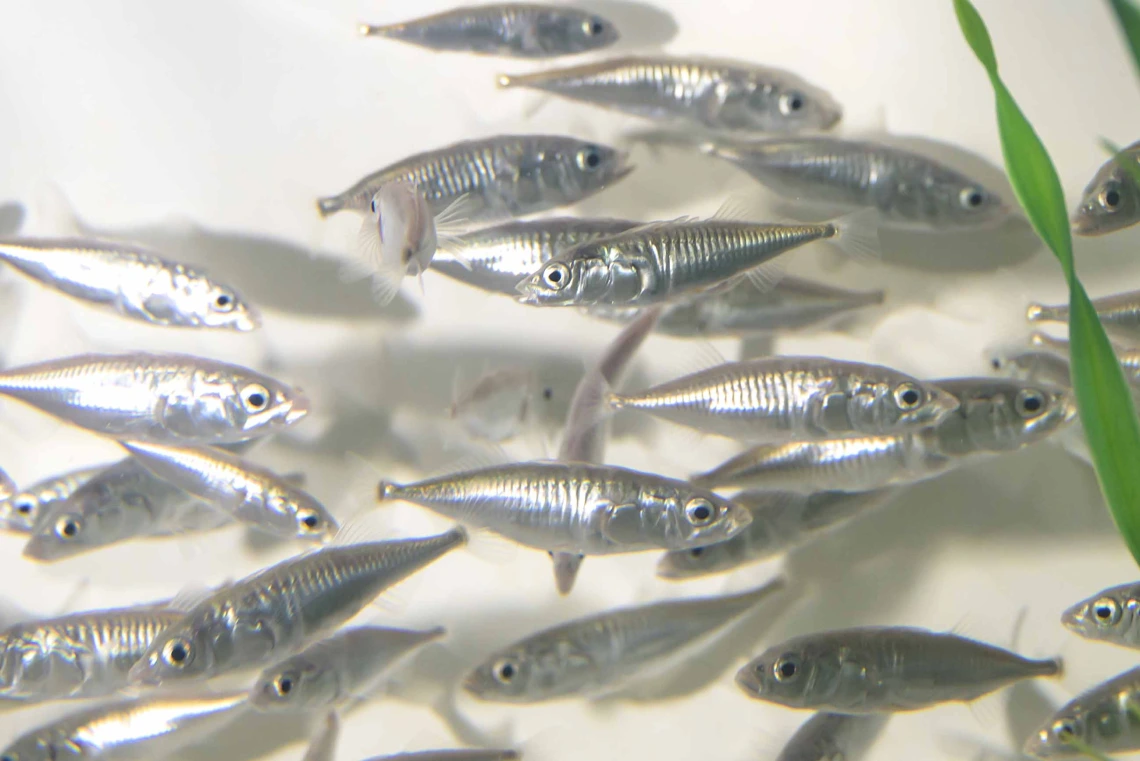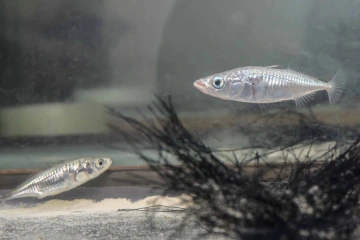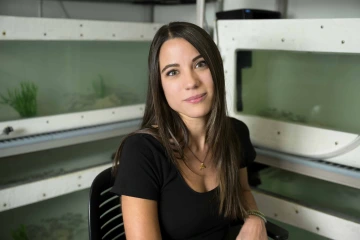Fish lab designed to spawn human health discoveries
Frank von Hippel, PhD, oversees a threespine stickleback fish lab that he believes will create new research collaborations and opportunities to improve human health.

The threespine stickleback fish in the One Health fish lab are carefully monitored to ensure that conditions in the tanks mimic those of their native habitat.
Photo by Kris Hanning, UArizona Health Sciences Office of Communications

Frank von Hippel, PhD, (left) works with a research technician to sample threespine stickleback at St. Lawrence Island for a gene expression study.
Photo courtesy of Frank von Hippel, PhD
The threespine stickleback, a small yet remarkable fish known for its adaptability and presence in diverse habitats, has captivated scientists for centuries. It played a significant role in the work of Nobel laureate Niko Tinbergen, who used it to study animal behavior, and remains an essential species for scientific study today.
“Sticklebacks offer unique advantages as a model for human health research,” said Frank von Hippel, PhD, director of the University of Arizona Health Sciences One Health research initiative and a professor at the UArizona Mel and Enid Zuckerman College of Public Health. “Their well-documented biology and genetic similarities to humans make them invaluable for studying the effects of environmental factors on health.”
Thanks to von Hippel, researchers can study threespine stickleback fish in a new UArizona Health Sciences laboratory. The lab operates within the One Health research framework, integrating human, animal and environmental health to give scientists from diverse fields an invaluable opportunity to tackle interconnected health challenges.
Leveraging the stickleback advantage
The threespine stickleback, or Gasterosteus aculeatus, is known for thriving in diverse aquatic habitats from oceans to freshwater lakes. Its adaptability and widespread distribution have led to pivotal contributions to science, including the 1973 Nobel Prize in Physiology or Medicine for discoveries concerning the organization and elicitation of individual and social behavior patterns in animals.

The male threespine stickleback, pictured swimming above a nest, is displaying the color changes, including a blue eye and pink nose, that accompany sexual maturity while the female’s color remains unchanged.
Photo by Kris Hanning, UArizona Health Sciences Office of Communications
“Sticklebacks are just an incredibly well-studied fish,” said von Hippel, who is a member of the UArizona BIO5 Institute. “We know more about the stickleback than any other fish in the world. This wealth of knowledge makes the stickleback a robust model for various research applications, including evolutionary biology, behavioral studies and ecotoxicology.”
The threespine stickleback offers several advantages over the zebrafish, which is commonly used as a model organism in human health research because, similar to the stickleback, it shares about 70% of its genome with humans and is easy to study in the lab. The zebrafish is a tropical freshwater fish native to South Asia, while sticklebacks can be found across much of the Northern Hemisphere. This geographical spread allows researchers to study sticklebacks in their natural environments, providing insights that are not possible with zebrafish, which are poorly understood in the wild.
“Zebrafish are only naturally found in the Indian subcontinent, so we know very little about them in the natural world,” von Hippel said. “In contrast, the stickleback can be studied in the ocean, estuaries, lakes and rivers, and their responses to environmental factors like climate change or contamination can be directly observed.”
Sticklebacks have a relatively simple genome, which makes them ideal for sophisticated genetic studies such as of gene or protein expression.
“Their developmental biology is very similar to our own,” von Hippel said. “Approximately 80% of human genetic diseases have corresponding genes in fish. This similarity allows us to study human development and disease mechanisms effectively using sticklebacks.”

Maria Eugenia Sancho Santos, PhD, DVM, oversees the daily care and maintenance of the threespine stickleback and assists researchers who collaborate with the lab.
Photo by Kris Hanning, UArizona Health Sciences Office of Communications
The stickleback’s genetic sex determination mirrors that of humans, with X and Y chromosomes that make them ideal for studying sexual development and the impact of contaminants on this process. Females of all fish species produce egg yolk protein, called vitellogenin, in response to estrogen, but stickleback are the only fish to make a protein in response to testosterone. The males’ glue protein is called spiggin and is used for nest construction. These unique qualities of stickleback allow researchers to study chemicals that mimic estrogen by measuring levels of vitellogenin in males, who normally would not produce any egg yolk, and chemicals that mimic testosterone by measuring levels of spiggin in females, who normally would not produce any glue.
The stickleback can even be used to study circadian rhythms, the physical, mental and behavioral changes a person – or fish – experiences over a 24-hour cycle. Researchers can manipulate environmental factors such as light and temperature and observe changes in the fish’s physiology and activity, providing insights into how circadian rhythms are regulated and how they can be disrupted by pollutants or other stressors.
“Understanding circadian rhythms is crucial because disruptions can lead to various health issues, including metabolic disorders, mental health conditions and even cancer,” von Hippel said. “The stickleback’s predictable and robust circadian patterns allow us to study these disruptions in a controlled setting, helping us to uncover potential therapeutic targets and intervention strategies.”
Creating a hub for interdisciplinary research
von Hippel is developing the One Health fish lab and its infrastructure to support a variety of research endeavors, including toxicology and developmental biology, the field that explores how organisms grow and develop. Researchers will be able to complement field studies with controlled lab experiments to gain a more complete picture of how environmental factors impact health.

von Hippel (kneeling in the foreground) with a team of reseachers sampling stickleback fish in their native environment on St. Lawrence Island.
Photo courtesy of Frank von Hippel, PhD
The lab’s budding fish population arrived from Alaska as embryos in June 2023. Maria Eugenia Sancho Santos, PhD, DVM, a postdoctoral research scientist, plays a critical role in maintaining the health of the fish.
“Caring for embryos involves frequent checks to prevent fungal infections and apply antifungal treatments. They hatch around day 5 or 6, and Maria then transfers them to aquaria,” von Hippel said. “As they grow they are fed various foods, including live brine shrimp, to encourage hunting behavior. It’s been a year since our first fish hatched, and they are nearly ready to breed. We’re also acquiring a new population from Oregon, which will give researchers access to fish from different ecosystems and genetic backgrounds for comparative studies.”
von Hippel got his introduction to the threespine stickleback in 1992 during his doctoral studies at the University of California, Berkeley. Guided by his advisor, behavioral biologist George Barlow, von Hippel studied stickleback behavior to understand broader issues in parental care and sexual selection. That foundational work paved the way for von Hippel’s transition to ecotoxicology, a scientific discipline studying the effects of toxic substances, especially pollutants, on the environment, wildlife, and people.
One of von Hippel’s significant projects involved studying contamination on St. Lawrence Island, a formerly used defense site in the Bering Sea. He found that the stickleback’s contaminant chemistry closely resembled that of the Indigenous population.
“Approximately 80% of human genetic diseases have corresponding genes in fish.”
— Frank von Hippel, PhD
“We studied several species of fish on St. Lawrence Island, and we found that the stickleback contaminant chemistry, more than any other fish, most closely resembled what we saw in people who lived there,” von Hippel said of the study that was published in the journal Environmental Pollution in 2017. “The Indigenous people there have high rates of cancer. We found that the stickleback at these former military sites also have many of the same biological features you get with cancer, such as disruptive gene expression and disrupted hormone systems.”
By leveraging the unique characteristics of the threespine stickleback, von Hippel believes the lab will create new opportunities for interdisciplinary biomedical research. To that end, the UArizona Health Sciences One Health research initiative is funding pilot grants to stimulate use of the lab. The goal is to generate new research that employs these fascinating fish to advance our understanding of human health.
Experts
Frank von Hippel, PhD
Director, UArizona Health Sciences One Health research initiative
Professor, Department of Community, Environment & Policy Department, Mel and Enid Zuckerman College of Public Health
Professor, Clinical Translational Sciences, College of Health Sciences
Member, BIO5 Institute
Related Stories
Contact
Blair Willis
UArizona Health Sciences Office of Communications
520-419-2979, bmw23@arizona.edu

